Text
Dawn of DC Comics – 3rd October – Fire and Ice, Blue Beetle and Birds of Prey #2s
My focus this week is on the second issues of Fire and Ice, Birds of Prey and Blue Beetle. After strong starts for all three series, the second issues varied drastically in terms of tone and pace to somewhat mixed results.
Fire and Ice: Welcome to Smallville #2
On a two axis scale of tragedy – comedy and deliberative – frenetic on tone and pace respectively, the frenetic comedy of Fire and Ice worked best for me this week. Joanne Starer and Natacha Bustos’ sitcom-style storytelling suits the diametrically opposite personalities of Fire and Ice well. Where the last issue ended on somewhat of a downbeat, with Tora announcing to Bea that she no longer wanted to be a superhero, the mere fact that these two women with such a rich history but with wildly differing aspirations and motivations have to live under one roof lends itself brilliantly to comedy.

In her conceptions of both characters, Starer is blatantly as sticking to type to accentuate the awkwardness of the pairing. Tora is the bookish hipster with a desire to expand her interests and cooling on the superhero game whereas for Bea the need to prove herself burns brighter than ever. The plot ratchets up to pure absurdity as their Smallville Barber Shop becomes inundated with the minnows of the supervillain world before becoming a low budget reality TV show with Big Brother style diary rooms held in the toilets, much to a queuing and increasingly desperate Tam’s chagrin. Bustos’ art is quite classically cartoonish in this issue, with over the top reactions from background characters in particular emphasising the farcical nature of Bea’s plan and its effect on Tora. The jokes really landed and I found myself laughing throughout. But the fun does stop eventually as Bea’s social media experiment begins to verge on dangerous, and tensions fray between her and Tora once again. However, in classic sitcom fashion, the arrival of Jimmy Olsen at the end of the issue ensures that Bea and Tora live to fight another die.
Blue Beetle #2
That said, Bea and Tora are certainly better off in their own series than they are during their appearance in the tragic and frenetic Blue Beetle #2. After an initial moment of contemplation as Ted Kord lies injured in hospital, in which Tora comforts Jaime, the issue moves at a million miles an hour as the Blood Scarab rips through the supporting cast of the issue one by one before getting to Jaime and declaring that that’s enough for one issue, thanks. Be back soon.
The action scenes are so dynamic and fast moving without being overwhelming largely because writer Josh Trujillo trusts Adrian Gutierrez to convey the chaos during these scenes. Occasional dialogue, typically reserved for characters remarking upon how screwed they are, serves as framing for Gutierrez’s creative use of panelling, which evokes the feeling of the Blood Scarab closing in on its victim, leaving them nowhere to run.
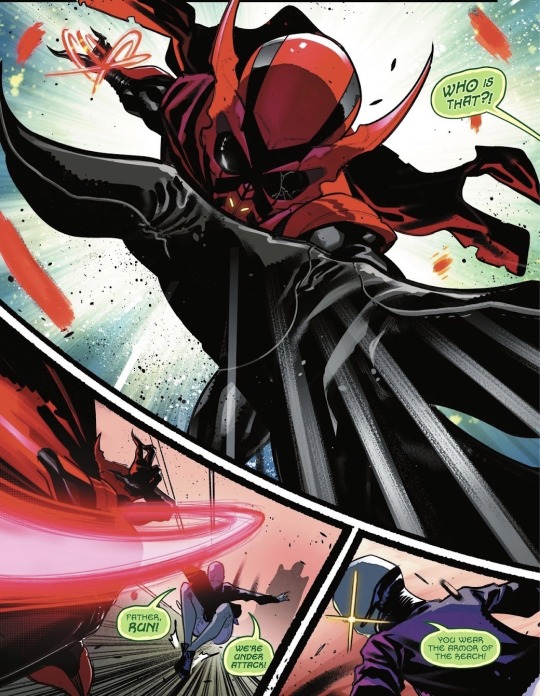
As a new reader my biggest issue with this series so far is that I actually don’t know much about Jaime Reyes himself so I’ve found it harder to connect with him than with the characters I’ve been introduced to in other Dawn of DC stories. This is not the writer’s fault, and I’m certainly not advocating a return to Shooter’s Marvel of the 80s where the first page gives you the entire character’s history all over again. I may be getting into background reading and research time which I believe is absolutely fine to expect of a reader, although not within the scope of this project initially.
Birds of Prey #2
In stark contrast to Blue Beetle, Birds of Prey #2 was rather more introspective and dialogue focussed. The team dynamics, by design, continue to be comedically awkward with each team members’ motivations being tested by a mission they signed up to without full possession of the facts. The pop art style doesn’t quite work as well as it did in Issue 1, with the lengthy conversations between team members feeling quite stiff. Bellaire’s colours feel slightly washed out because of the darkness of the setting (a dimly lit basement room), which contributes to this lack of momentum in the scene. The tension between Harley Quinn and Black Canary drive provide the scenes with the most comedic energy, but the other team feels peripheral. This means that when characters like Zealot and Barda receive a bit of focus, they are brief and less compelling. The series in its early stage are an intentional pivot away from the warmth and friendship of Gail Simone’s conception of the team, which can make it feel unrecognisable as a Birds of Prey series at times. That said, friendships aren’t forged overnight, and there are already signs of promise between Barda and Cassandra Cain for example, so I’m not writing this off as a destination point for the series.

Where the issue does excel is in the fight scenes, where Romero’s style becomes much more kinetic, with the setting lending itself far more to pops of pastel colours. This issue serves as a bridge between the opening salvo of the team come together for the first time and their mission in Themyscira. With the team leaving the darkened basement and taking to the sea, King Shark in tow, the comedic tone to the series should come into its own.
#dc comics#fire and ice#blue beetle#birds of prey#jaime reyes#black canary#harley quinn#cassandra cain#big barda
7 notes
·
View notes
Text
The Flash #1 - super speedy thoughts
This form meeting content post is not by design but due to a severe lack of time this week. It’s also not because I didn’t enjoy The Flash #1 because I very much did, at least the second time. It turns out that being introduced to a whole cast of new characters and a concept as abstract as the speed force all in one go would have been a tough assignment anyway. But when you overlay Si Spurrier’s content rich and some dense writing style, it definitely took me a second read to a) understand what was going on and b) become invested in the story.
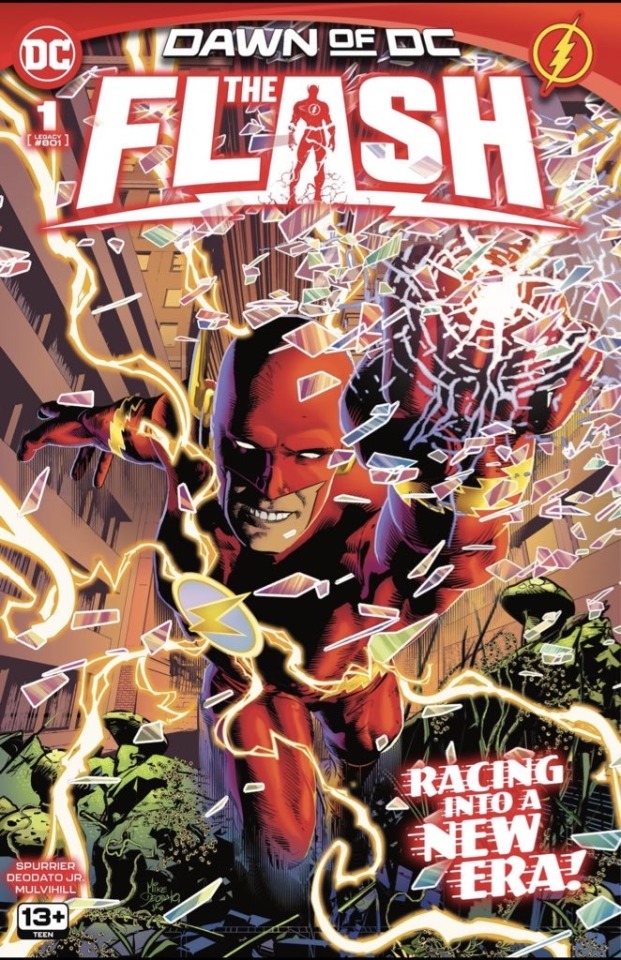
I’m glad I gave this a second read through because Spurrier is really playing to his strengths in the horror genre, and Mike Deodato is excellent at splash pages with beautiful and overwhelming intricacy. All of this contributes to a high concept story about time, and how it’s coming apart at the seams in a world in which everything is fast now. It’s no wonder that even the Scarlet Speedster is overwhelmed.
One scene that immediately resonated with me is Wally and Linda’s cross-communication where she is trying to get him to slow down and empathise with what appears to be post-partal depression, but he just doesn’t seem to be understanding her loneliness.
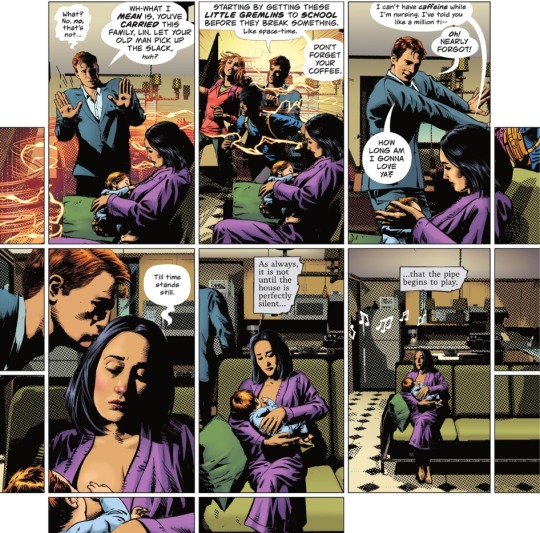
Overall, a really good issue that I’m glad I stuck with. Can’t wait until issue 2.
1 note
·
View note
Text
Power Girl #1 Review
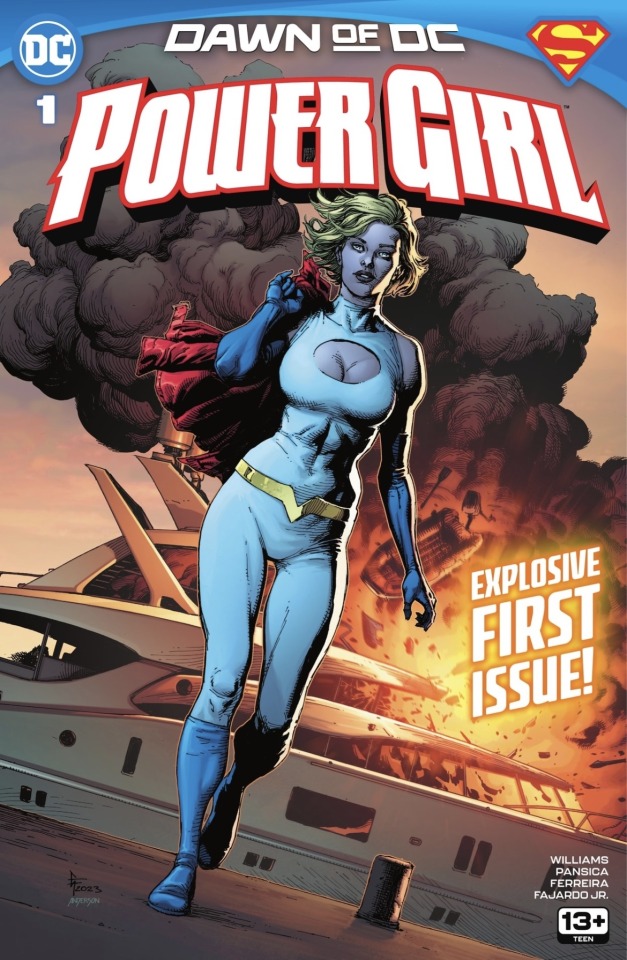
Power Girl #1’s cover promises an ‘explosive first issue’ and, as least as far as the prospects for Earth-Atlantis relations go, delivers on its claims in a fun, action-packed opening salvo to Dr Paige Stetler aka Power Girl’s foray into eco-science. The issue deals with the complex layers of Paige’s identity and how she is effectively held accountable for elements of her identity she has no control over. The story explores the themes individual liberty, environmental sustainability and begins to play around the edges of the question of whether earth would be better off without the Super Family.
The issue opens with a familiar sight: a bunch of poorly groomed bigots with dreadful chants and an even worse imagination for slogans shouting about aliens. Even a loudspeaker can’t save them because absolutely no one is listening. The four panel layout on this page really sells this transition, with the focus panning out, then away from them before shifting entirely to the merry revellers aboard the charity fundraiser boat, with Becca Carey’s ‘ha’s permeating the panel to emphasise the point.
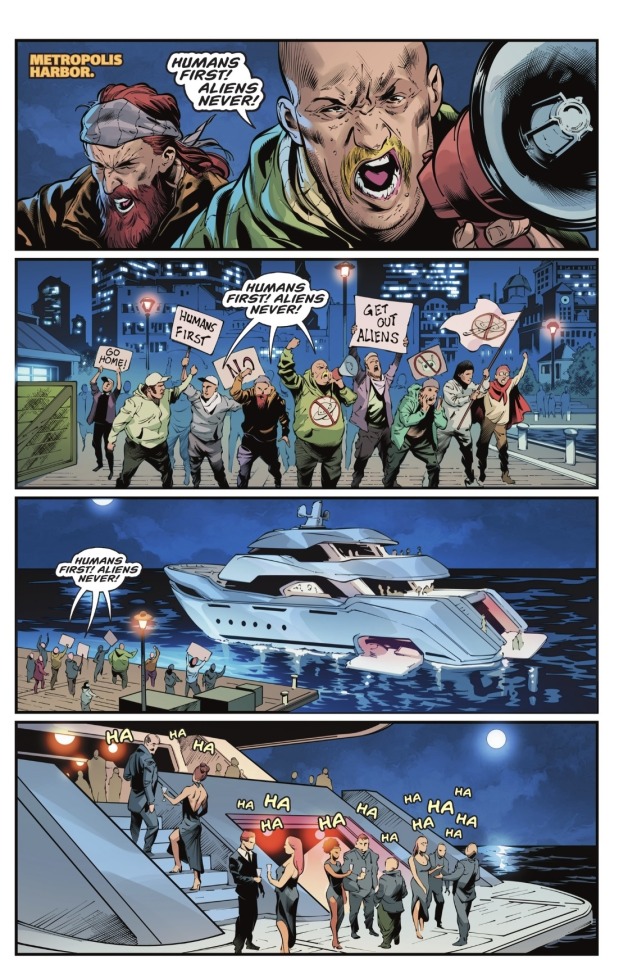
That said, the theme of prejudice far from disappears from the issue. Williams instead keeps it lurking in the background, briefly popping up again as an unidentified male trying to head hunt Paige at her own event.
Anyway, the incredibly expensive alien tech being auctioned off is wanted by a particularly scrupulous new villain Amalak. Amalak’s message to the crew of “desperately ignorant” elderly white men on the docks is that prejudice may be a perfectly reasonable hobby for a gentleman without prospects, but it really isn’t a vocation. While his primary objective is larceny, upon discovering the superhero formerly known as Karen Starr is a Kryptonian, reveals that such is the strength of his hatred that he happens to have brought a weapon with him designed to destroy them. Williams and Pansica use a series of three consecutive panels to draw commonalities between the human protestors, who are delighted to have their point proven by an alien right, and Amalak’s more specific, nuance kind of hatred. He claims that Kryptonians are colonialists, interfering with the natural evolution of others and, in his home world’s case the death of the planet. His indirect critique therefore is that by intervening in the affairs of a planet and people’s lives, the Kryptonians have made them weak by solving all of their problems for them. This begs the question as to whether they are free in the ‘positive liberty’ sense. Are they being equipped with the tools they need to thrive?

The fact that someone out there has created a disease specifically designed to infect and weaken Kryptonians poses an interesting question: do the Supes inadvertently cause the decay of critical thinking and progression?
Paige’s accusation that humanity’s environmental sustainability efforts have been farcical as, to date, a lack of commitment to meaningful change implies that Williams is preparing to argue otherwise. And furthermore, who has a vested interest in ensuring that society does not continue to progress in this way? All, I’m sure, will be revealed.
On a lighter note, the real highlight of this issue for me was Power Girl and Omen’s relationship. Pansica’s art does an excellent job with their body language, emphasising their tender, bordering on romantic, affection. Williams captures their seamless repartee, which is hidden from everyone else in the scene but shared with the reader. Power Girl’s facial expressions are bold and emphatic, which is matched by the dynamic art throughout the fight sequences, with Power Girl finding solutions quickly to the different problems thrown at her.

Overall, a great first issue.
4 notes
·
View notes
Text
Wonder Woman #1 - Brief thoughts

Wonder Woman #1 was bold and I give it immense credit for that. The way the narrative escalates the hostility, shows how it spreads and reveals the methods of the guiding hands who fuel it worked so well.
The Sovereign’s plan features all the tricks of the fascistic trade: false aggregation of the actions of an individual to represent a group, replacement theory, hostile anti-immigration, genocide enshrined into law. These are all sadly familiar to the everyday lives of oppressed minorities in America.
Sovereign’s description of Diana’s fighting style as a dance felt very apt; something innately feminine and not understood, therefore intimidating and deserving of suppression. Artist rather than soldier.

Same here, at the beginning of the issue, her hands are described as ‘dainty’ and are linked to their ‘humiliation’. This demonstrates that while the Sovereign’s campaign is very much based on manipulation of the wider populous, their language is encoded with misogyny throughout.
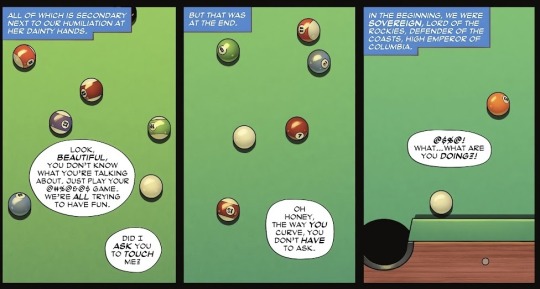
That’s why the reason behind all of this being a shadowy organisation wielding a lasso of lies, even metaphorically, felt a little on the nose to me. There is still a danger of oversimplification here, because while the root cause of misogyny is a strategic desire to maintain patriarchal hegemony, it’s clear that these beliefs have seeped into even those holding the lasso of lies. If everyone involved in maintaining male dominance is being manipulated by the lasso, it implies that the inanimate object agency over everyone. If the origin point of this ideology is not an actual person or group of people, it falls a little flat.
That said, I’m sure there’s more to be revealed, and I trust King on the basis of this issue so I’m not holding it against the series.
4 notes
·
View notes
Text
Green Lantern: War Journal #1 – Quick thoughts
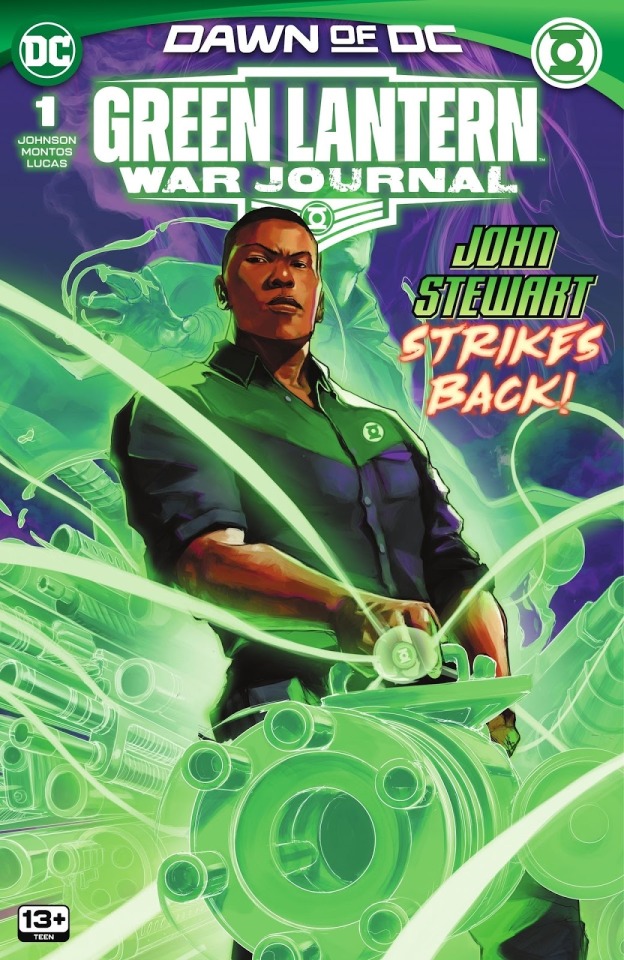
I’ve been enamoured with the story potential of this series since reading the backups in Jeremy Adams and Xermanico’s Green Lantern series and this issue did not disappoint. I foundJohn’s struggles to care for his Mum’s dementia very poignant from a personal standpoint as someone with a close family member suffering from the illness. The symbolism of deconstructing a clock just to put it back together again for sheer enjoyment is tragically poignant in its application to the enjoyment of revisiting memories with someone suffering with the illness.
He initially busies himself with tasks around the house, delighting his Mum who revels in his love for fixing things and using logic to make them better. However, it is a problem of an illogical nature that John needs to solve for his Mum.

Tragically, she doesn’t remember that her daughter has died and, to solve the problem, he constructs her using his lantern powers, applying the same methodology he does with the broken clock to put her back together. We get a painful reminder of his Mum’s condition when she refers to the broken clock again, although it takes on a bitter irony as her memory prevents her from seeing this is exactly what he has done to protect her from experiencing her grief all over again.
6 notes
·
View notes
Text
Titans #3
Getting the band back together is a classic trope. Reuniting with your teenage friends and moving back into your old digs even more so. These stories work well because in comparing past with present selves we can easily identify who has changed, whose growth has been somewhat stunted and, increasingly these days, who has joined a cult called something like, I don’t know, the Church of Blood.
NB: Quote from a church spokesperson: “it’s not called that anymore”).
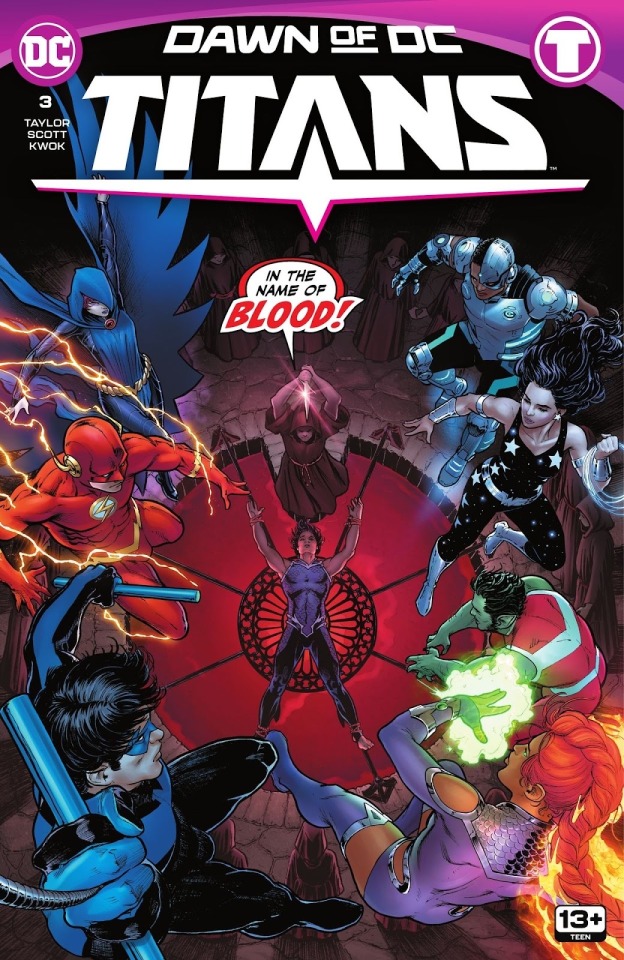
The new series of Titans focuses on the classic teen super team’s heroic propulsion into the big leagues. The JLA have disbanded, the JSA are involved in what must be very time consuming time travel shenanigans. It’s all on them, and Nightwing in particular is desperate to prove he has what it takes to step into his erstwhile role models’ considerably large black boots.
The plot thrust of the first three issues is the return of the Titans’ nemesis the villain formerly known as Brother Blood, now calling himself Brother Eternity. His new venture, the Church of Eternity is pledging to save humankind by removing them from the earth, which he claims is totally a lost cause. Most notably, he has gained the support of former Titan member Tempest, whose concern over humanity’s treatment of the sea has caused him to take desperate measures. We discover by the end of the third issue that, surprise surprise, he’s full of shit and that he’s been keeping a meteor in his basement for reasons yet to be revealed.
I have to be honest, I couldn’t care less about the plot of this book. As a reader new to DC (in case you weren’t aware of the purpose of this blog), I’ve found the dynamic of the team the most intriguing element, and in particular the team themselves observing how the dynamic has changed. Particularly great is seeing the team interact in a domestic setting. Donna Troy being promoted to second in command above Star Fire, suggesting a role reversal since the team have been apart and a potential point of conflict.

Beast Boy seems to have gained confidence from dating Raven. Tempest has joined a cult. Wally West seems to excuse himself completely from this new hierarchy Nightwing has created and will not follow orders even to save his own life thank you very much. After all, as Dick says, he has a wife and kids so they can’t really make him live with them. Again, nothing too untoward for now but the development of each individual member and the dynamic of the collective has clearly changed.
3 notes
·
View notes
Text
Batman and Robin #1 - brief thoughts

This was the hardest issue for me to get into as a brand new reader. Firstly, I don’t know the significance of Bruce and Damian Wayne being back together, although it’s fairly apparent that they’ve been leading divergent lives.
I also assume that Bruce isn’t particularly happy about Damian acting like a rich kid know-it-all and is keen for him to live a more grounded life. Seems too late for that.
The action scenes were drawn beautifully. Di Meo’s blurred neon lights whirl around with the darkness of the black in the night time scenes.
Overall while I found it a little difficult to get into, there’s enough there to keep me on board.
0 notes
Text
Green Lantern #1-3 - Quick post

Ok I cheated a bit and did some back reading, but it was only 2 issues so I’ll forgive myself. I’m really glad I did, because I’m really enjoying this series. The first two issues left a lot of space to get a sense of Hal Jordan as he finds his feet in the real world, which was a great experience for a new reader. He’s clearly making the best of it through sheer willpower, despite having no real purpose outside of the Lantern Corps. John Stewart, by contrast, has a clear responsibility yet it still just waiting for life to come and whisk him away back to what he knows best.
The scenes in an alternate universe where we see John living up to his full potential as a living embodiment of the ring’s power was amazing, and I can’t wait to see the Earth 0 version fulfil his purpose again.
1 note
·
View note
Text
Batman: Gargoyle of Gotham #1
The politics of the Gargoyle of Gotham
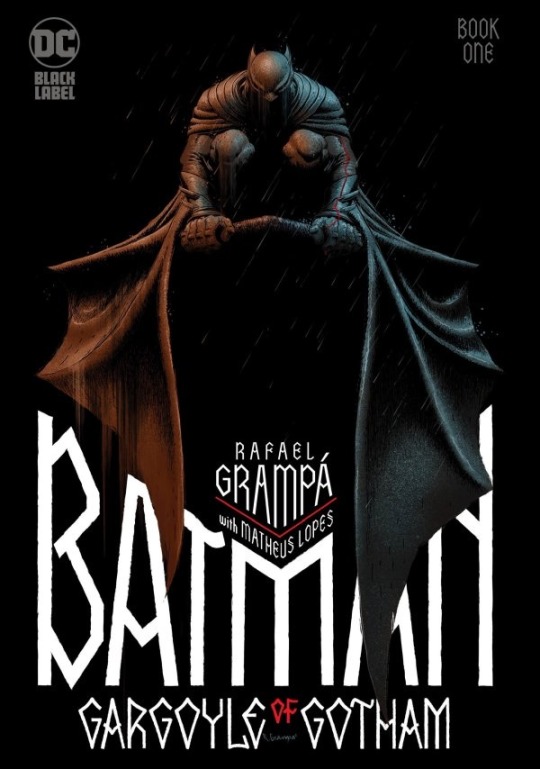
This week I’ll be focussing on DC Black Label’s Batman: Gargoyle of Gotham #1, written and drawn by Rafael Grampa and coloured by Matheus Lopes. The series explores Batman struggling with his dual identities of the caped crusader and the billionaire Bruce Wayne as he begins his investigation into a mystery that highlights the contradictions in his plan to ‘kill’ his privileged position to focus on combatting Gotham��s inequities and corruption.
Grampa makes the most of the Black Label designation in his portrayal of Gotham’s forgotten working classes through a series of narrowly stacked panels that lay its impoverished underbelly bear. The clear detail of the background scenes depicting the symbols of the city’s moral degradation - substance abuse, domestic abuse and illegal sexual proclivities - is contrasted with the obscured faces of the perpetrators of society’s ills, emphasising its the ugliness of the city that shapes its citizens. His art sensibility feels akin to Frank Quitely in the way he warps bodies and faces to add to the sense of scene, and to Larry Stroman’s interest in bringing background figures into sharper focus, meaning that every building sign and every person equally comprise Gotham as a place. Each scene evokes a sense of power imbalance, of abuser and abused, which is just one ladder on the food chain that the issue will establish as central to the city’s problems.
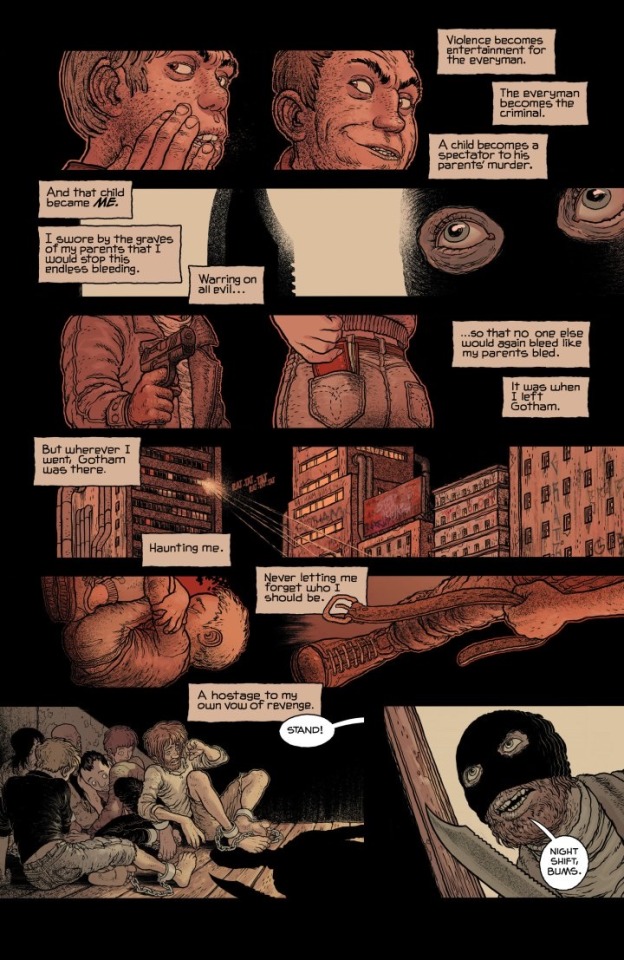
Now for the top of the food chain. The issue’s political manifesto is laid out explicitly by Nia, the budding young journalist who has uploaded her thoughts to her NGO employer’s social media. Grampa uses a character more grounded in the realities of day-to-day life to represent the view of the city’s working classes in a way that is startling direct, if a little overt. Nia argues that the rich are at the top of the predatory hierarchy in the city, stating that “In Gotham, violence against the poor is invisible, while violence against the rich is a tragedy”. The result of their lack of compassion is “no justice” for the working classes in the city, and that the rich not only “pretend they have nothing to do with it” but must “assume their enormous responsibility for all of this”. She concludes that “it is time to seize power from those who have the most” and is immediately proven right when her piece is suppressed by her “bootlicker” and “hypocrite” of an editor afraid to brush up against the power of news corporations. Her language, if a little drenched in the idealism of youth, sees through the entrenched excuses. It also reflects the nature of the investigation into the deaths of four rich Gothamites, which has drawn the attention of Batman in a way that the ongoing crises facing the city’s working classes do not.
So, where does Batman fit into this picture? Well, there are two important things happening here which become more and more connected as the story progresses. Firstly, his identity crisis. Batman’s central premise is that for him to be able to fulfil his purpose, Bruce Wayne must disappear from the public eye. In light of Nia’s characterisation of the rich, not the poor, as the blight on the city, simply removing himself from the food chain is a decision seeped in and a misuse of his privilege. The issue engages in the debate that few want to have, but Batman’s position is established to be that he can do more to combat society’s inequities by punching the low-level criminals and working his way up than accessing the higher echelons of society through his economic status as Bruce Wayne and investigating its root causes. Quibbles over the final details of his multi-million dollar tech serve only as a reminder of this contradiction, and further emphasise his well-intentioned but misguided idealism about what a street level superhero is and represents. The villain of the story seems likely to pose these questions to him, and I would anticipate that the moral of this story is that Gotham needs Bruce Wayne as much as it needs Batman.
The second element of this is our villain – the Crytoon man, presumably Dr. Charles Quinton. The most obvious connection between our mystery crying man and the theme of economic equality is that he’s killing the rich. The second, more compelling throughline, involves the cartoon he is clearly obsessed with, one that makes him cry in pain as its protagonist also does. We know that the cartoon was banned after it had sparked a violent incident at the school, and that it appears to focus on a masked child quite literally punching down at animals. Although we know precious little else about the content, the cartoon is a transgressive metaphor for the hierarchical nature of capitalist systems, that those without power are forced to find and oppress those lower than them. It is notable in Nia’s speech about the value of the poor in society being predicated on their ability to produce for it, and that they are treated as “less than human” for not doing so, which suggests that Dr. Quinton’s actions are in some way designed to highlight this inequity further. His confrontation with Batman at the end of the issue places him as the middleman in this societal food chain, having been discovered previously as exploiting vulnerable people to make TNT. He seethes as he says “I know you crave the satisfaction of showing me what I deserve. By embarrassing you”. This, in combination with Commissioner Gordon’s revelation that he visited Bruce at Arkham, suggests that he knows full well the connection between Batman and Bruce Wayne, and he is not willing to let him forget it. He views himself as exploited by the system that lauds the rich and forgets the poor yet is forced into participating into this inhumanity by its conditions.
Returning to Nia’s speech one final time, and to her assertion that a person’s value is not defined by their ability to contribute to the prosperity of this inequitable system, that this is a lie told to perpetuate the exploitation: Quinton is positioned as a man who has entirely bought into the lie and is living out its inherent hypocrisies. He is, in that way, a mirror to Batman, and will surely become a lens through which Bruce Wayne comes to view himself and his place in the world.
1 note
·
View note
Text
Penguin #1 - Short Review

Tom King’s Penguin #1 is a day in the life story of the former Gotham crime lord adjusting to life in Metropolis. The issue observes Oswald going about his daily routine from several onlookers’ perspectives, and paints the picture of a man content in his new life. King makes it clear throughout the issue that this is a man reformed: he is tested several times by increasingly aggressive and morally questionable characters, and yet his resolve never breaks. Not only does he turn the other cheek but he proactively goes out of way to rationalise others’ viewpoints and turns them in on himself. Just as karma begins to naturally wing its way into Oswald’s world after a misogynistic customer insults him, his circle of sedentary life is broken.
King’s use of imagery during this slow build of tension is pretty unsubtle. At one point the viewpoint character even references Oswald’s open palms rather than closed fist, to really make sure the reader gets it.

Anyway, Oswald’s motivations are twofold: his personal liberty, driven only by the calming influence of a life for life itself. And the love for his wife. When both are taken from him after his arrest by Agent Nuri Espinosa acting at the behest of Amanda Waller. There’s very little mention of evidence presented on Penguin’s crimes, which seems curious given his much vaunted skill as a criminal referenced several times throughout the issue. Ultimately that doesn’t matter though.
It turns out being blackmailed with a return to his past life is enough of an incentive for Oswald’s habits to die hard. Fair enough I suppose. His first stop: back to the doting and unintentionally insulting tailor who opens the present day story, and he violently assaults him in a delayed act of vengeance for his previous indiscretion. The choice of this character as the starting point for Oswald breaking bad is a smart one, particularly in consideration of how the issue ends.
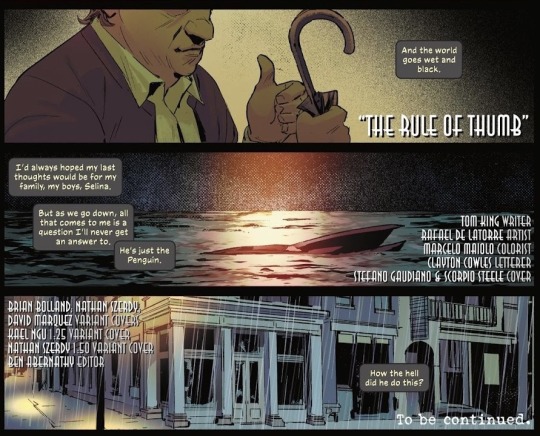
The issue is bookended by scenes set one year in the future, with an event perpetrated by an unnamed ‘she’ (presumably either Waller or Espinosa) in revenge against the Penguin, which leads to a catastrophic future event that even threatens Batman’s life. This sets up the start and end points of Oswald’s ascent back into a life of crime, and its victims. The tailor is very much at the bottom of the scale, whereas Batman is at its zenith. The series’ brief now is to show quite how Oswald climbed this tower, and fell again quite so quickly. I’m intrigued, if not entirely gripped at this stage.
1 note
·
View note
Text
Blue Beetle #1 - Short Review
In addition to Birds of Prey and Fire and Ice: Welcome to Smallville, the third DC #1 I picked up this week was Blue Beetle. As a completely new reader, I was slightly intimidated coming into this as a) I don’t know the character’s backstory or the Scarab lore and b) there’s quite a sizeable cast on the cover of the issue. I was pleasantly surprised at how accessible the issue was, but can’t help but feel as though I lost out on the excitement of the issue’s end.

Trujillo and Gutierrez set a relatively slow pace throughout the issue that gives them space to detail key backstory elements and establish most characters’ tone of voice and their relationship to Jaime. The immigrant analogy set up for the Horizon was particularly effective as it described their status in the human world relative to their overall cosmic significance in a very economic way. This is an interesting storybeat I’m keen to see more of.
But, if there’s one thing I’ve discovered as a new reader this week it’s this: if you can accept that not everything will be revealed to you right away, it’s pretty easy to pick up information as it’s communicated. What you lose out on is the sense of drama created by, for example in this issue, a villain reveal at the end. This flattens the reader experience somewhat, and it was more notable in this issue than the other two DC issues I read this week.
Because of the slower pacing to the story generally, the build up to the reveal was a little bit of a dead end for me. I don’t hold this against the story though so I’m going to keep reading and hopefully get more into it as it goes on.
3 notes
·
View notes
Text
Fire and Ice #1

Spoilers for Fire and Ice #1
As might be expected from a book about Fire and Ice, the series’ first issue explores the contrast between the people whose names and powers represent this elemental duality. The first issue of ‘Fire and Ice’ tells the tale of Fire and Ice’s second chance at herodom operating out of a hair salon in Smallville. Joanne Storer, the scripter for the series, interrogates the ways in which Bea and Tora’s powers influence their habits, motivations and actions while distancing them from being completely defined by their monickers. She explores the very personal conflict that exists at the heart of their relationship while questioning, at least for the time being, the premise that one requires the other as a counterforce and balancing presence.
The opening pages are extremely accessible for new readers, with the opening panels displaying the two team mates’ power signatures immediately. The dialogue is contrasted with the connotations of people who could be described as ‘fiery’ or ‘icy’, with Tora on the offensive and Bea sat quietly despairing over the consequences of her actions. The title pages, set two weeks after the action of the issue, provide a quick overview of their character histories and lay out their motivation, providing new readers all of the context they need. It also reverts the character back to the associated personality types of Fire and Ice, implying a dramatic shift between the characters’ current state and the one they find themselves in. Bea, desperate for ‘International Fame’ and ‘done being under-estimated’, is confident, perhaps even complacent, whereas Tora’s deferential, shy demeanour feels more congruous with her power set than the opening page does.
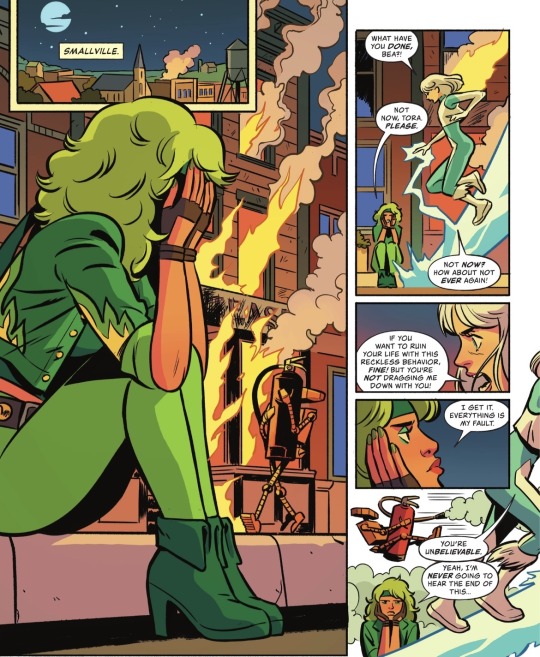
It doesn’t feel like a stretch to suggest that Bea and Tora’s identity as Fire and Ice have been shaped by stereotypes of their cultural identities in the past, with the ‘fiery Latin’ and ‘laid back Scandinavian’ tropes reflected in the personalities and powers. Storer and the art team of Natacha Bustos (art) and Tamra Bonvillain (colours) don’t set out to break the determinist nature of the characters but provide nuance and build complexities into characters who have presumably been characterised fairly one dimensionally in the past. The issue’s opening, portraying the culmination of the disaster brought onto Smallville by Bea’s impatience and impetuousness, without Tora’s stable presence, provides an indication that we are only seeing the very beginnings of their descent back into disrepute.
Fire’s quest for respect and repute takes absurd turns, including taking to social media to invite enemies to challenge her culminating in a poorly rehearsed TikTok dance and doubling down on her ‘mistakes’ by contacting a character I assume the reader should know at the end of the issue. Her fiery single-mindedness and desperation to be needed will likely be the cause of further conflict to come, and it is telling that not even Tora’s early resignation can divert her from her course of action.
However, Starer weaves in elements that imply a deliberateness and sense of planning to Fire’s approach. She is shown to be conducting detailed research on future potential enemies, using dossiers as well as her dodgy social media content to formulate a plan to achieve her goals. Single-minded: yes, impulsive: not so much.

Ice on the other hand, is drawn as laidback and carefree throughout Fire’s plan hatching. Bustos uses a four panel layout, with one vertical panel on the left of Martha Kent interrupting their argument with Apple pie, matched to three quickfire panels on the right, each of which are Tora merrily busying herself to evade conflict with her partner.

By contrast, Storer gives her significantly more dialogue when she is away from Fire, and it is at the diner that her motivations become clearer. Storer brings in Raquel Rhodes as a symbol of the life Tora wants: free to exist without a plan, connecting with others and living life in the present. It is then that Fire’s social media campaign breaks her out of her peace. Tora’s desire to avoid conflict causes her to act impulsively, however, which further demonstrates the nuance Storer gives to the characters. When Tamarind, the former stylist bumps into her with a CV, she instinctively gives her a job, despite having no plans to operate the salon as a business.
When Fire’s social media campaign invites King Shark to town, placing the people of Smallville in jeopardy, the undercurrent of conflict between the two begins to rise to the surface. Storer, at various points in the issue, seeds the looming presence of male heroes and their role in the pair’s lives, which the two are shown to have opposing views on. Fire’s resentment at having Superman dictate their lives after his castigation of the pair over the damage caused to Guy Gardener runs counter to Ice’s belief that Clark has their best interests at heart and that a moment of reflection is needed before they proceed. So when Superman shows up again to take down King Shark, having ‘had to save them again’, their relationship frays to breaking point. Unhappy at being ‘disrespected’, Bea sees Superman’s intervention as an extension of male chauvinism while Tora places the blame squarely at her feet. The dynamic panelling of this page soon shifts to two sets of opposing panels on the next a Tora’s body language is once again tentative. Her face is drawn as facing away from Bea’s, her eyes down as she clutches her arm in search of courage in this moment. Tora’s dialogue is equally tentative at first as she uses the passive tense to declare that ‘maybe it’s time to accept that it’s over’, before delivering a slightly more decisive ‘I know for me, it is’. Bea, determined to hide her pain, storms off before once again exhibiting her pragmatic side: ‘But I signed a twelve-month lease, so I’ll be upstairs!’.
Fire and Ice #1 was a great first issue. Not only did it establish the characters’ voices and motivations but unravelled the inner conflict between them. The crucial details are in the times the two are apart, with both becoming more entrenched in their opposing beliefs and it is notable that at the end of the issue Tora is amongst the people of her community while Bea hatches further plans alone upstairs. This would suggest to me that something severe will have to force them back together, and I am fully invested in their journey.
1 note
·
View note
Text
Birds of Prey #1 Review
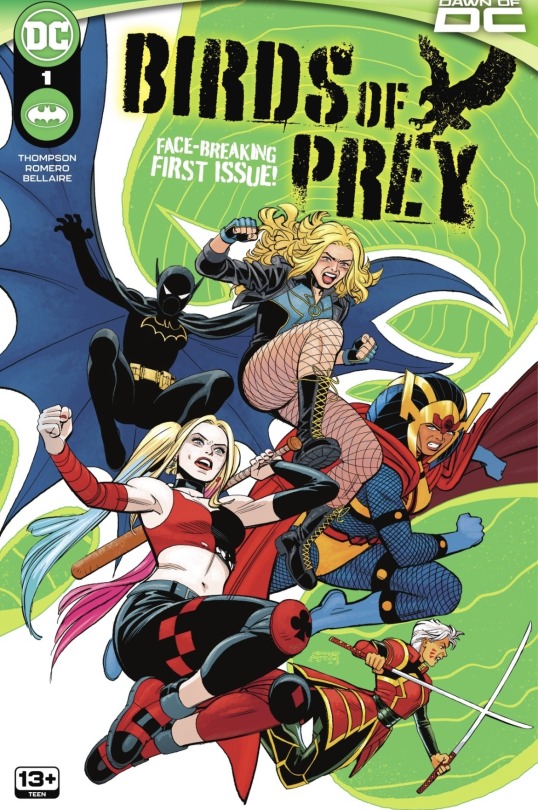
First things first, I have a huge soft spot for team assembly issues. This is in large part because it’s a great opportunity contextualise each characters’ starting point from a practical and emotional standpoint, and for creating either a common goal or sowing discontent amongst the cast members. They become doubly useful as a reader entirely unfamiliar with the characters as a quick download of a characters’ personality, their powers and their pre-existing relationships with one another.
Spoilers for Birds of Prey #1
Birds of Prey #1 has all the hallmarks of an opening issue, with Kelly Thompson and the art team of Leandro Romero and Jordie Bellaire guiding the reader through the mystery that, by the end of the issue establishes the mission, the stakes and the future dramatic tension within the team. The story opens with Black Canary beginning a mission to save her sister Sin, given to her with an unnamed ‘She’ later revealed to be Meridian, from the clutches of the Amazonians in Themyscira. The stakes: the inadvertent end of the world. Along the way, Dinah Lance (Black Canary) recruits Cassandra Cain Big Barda, Zealot and, after some resistance, Harley Quinn to the team. The team’s motivations range from just wanting something to do to making sure “cool-ass little girls get to grow up and become cool-ass women”. Both Cassandra and Big Barda are aware of Sin already, which I’m unclear is because of their history with Sin or whether she’s someone I as a reader should know, but hopefully this will be clear later. While research isn’t strictly forbidden from this process, these essays will be written from the lens of a new reader accessing these stories for the first time, so I’m going to see how this one plays out.
To this end, the delight of this issue is in the journey rather than the destination, with the process of recruiting each team member the heart of the issue. Thompson establishes the character voices of each team member and the relationship between them initially through a series of one-on-one scenes, which establish Cassandra as a quiet and purposeful elite fighter, Big Barda as a lofty ‘New God’, Zealot as a short tempered and impatient warrior masking some kind of physical ailment and Harley Quinn as a principled if a little reckless singular force of nature. It’s apparent that her characterisation of Harley is railing against expectations a little bit, particularly in establishing her motivation as slightly altruistic, which challenges Dinah’s perception of her as untrustworthy and a ‘risk’. Thompson hints at a tense history between the two, and an opportunity for tension within the team as a result.

Harley Quinn’s appearance in the book has the same effect it has on the team. Much of her dialogue focusses on her discussing her own motivations, and challenging Dinah’s leadership, and she dominates most of the scenes that she’s in. She’s both reader stand-in and exposition funnel, both of which devices are managed deftly without detracting too much from the pacing of the story. The structure of the issue, with the rest of the team being recruited first, is therefore really effective in ensuring that the reader has a sense of the other characters and, despite their somewhat tenuous links to one another, the stability of their composition as a team. The way Harley is introduced, through a flashback scene, accentuates her value to the team and creates a mythos around her that perhaps indicates the narrative focus she might carry in future issues. I hope this isn’t the case, as she is by far the character I’m already most familiar with, and getting a sense of the other characters will probably be crucial in my enjoyment of this series as a team book.
The art absolutely defines the tone of this book, and combines kinetic action sequences with a pop art style that gives the book a classic feel. The close ups of characters’ faces throughout the issue capture emotions frozen in time like iconic pop art portraits of the mid-20th century, and suggest that the characters, and the team overall are icons that are deserving of their status in the DC Universe. The background colours, typically either black or washed out shades of yellow, white and green, foreground the colour of characters’ costumes, again giving each character a unique and iconic presence on the page. The all-female cast lends itself to this point, and makes it somewhat of a political one, especially in consideration of Birds of Prey’s somewhat patchy appearances in DC Comics publication history.

The fight scenes are punctuated by Clayton Cowles’ similarly pop art lettering, with sound effects moving in tandem with the movements of characters’ bodies as the wreak destruction on their surroundings. Characters are generally still when talking, which brilliantly accentuates the deliberate focus of their actions in combat, every punch and kick executed with ruthless poise.

Overall, not only was this issue both accessible to new readers and a great introduction to the characters for a new reader. That said, knowledge of DC lore through films and cartoons certainly helped fill in a few blanks. None of that, however, detracted from the reading experience. Not does the issue set the plot up well but I am invested in each character moving forward. The verdict: keep going!
#dc comics#comic books#comics#comic review#birds of prey#harley quinn#black canary#cassandra cain#big barda
15 notes
·
View notes